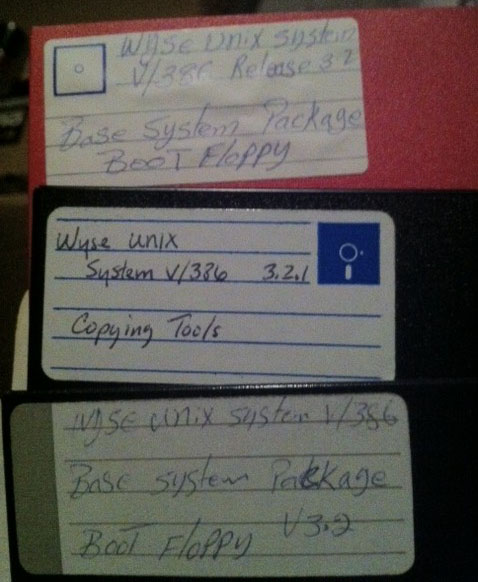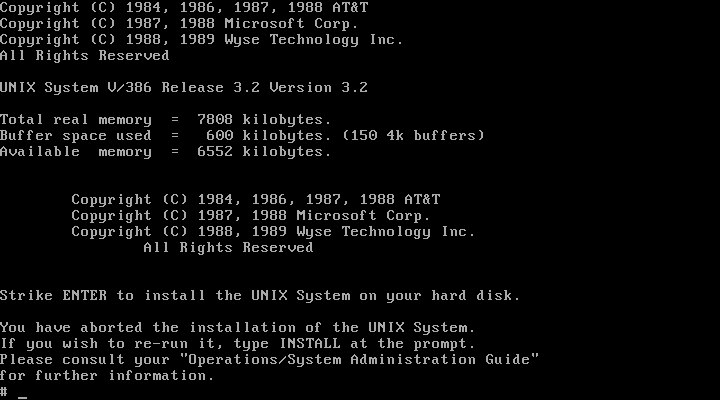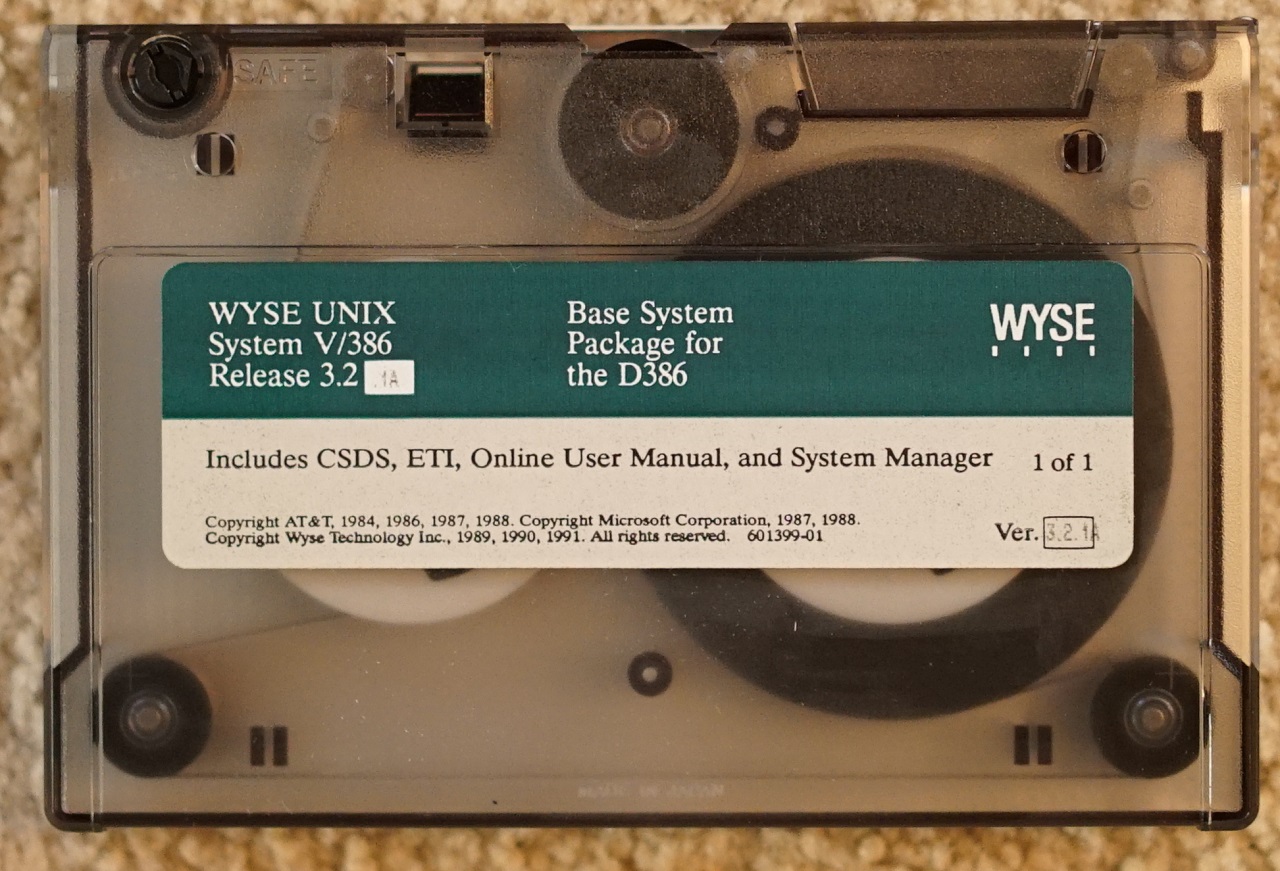(this is a guest post from Tenox)
The second virtualization contest is now on! Similar to the previous one, the winner receives $100 via Paypal and the submission is posted on this blog! Hopefully this one will be little bit more challenging. 🙂
The subject is the rarest of the rare WYSE Unix!
The progress so far: A few years ago I came in to possession of a set of floppy disks pictured here:
 Thanks to Al Kossow from bitsavers.org the floppy disk content has been recovered. Michal Necasek of OS/2 museum successfully converted them in to an usable format and made some modifications to get them to boot on VirtualBox:
Thanks to Al Kossow from bitsavers.org the floppy disk content has been recovered. Michal Necasek of OS/2 museum successfully converted them in to an usable format and made some modifications to get them to boot on VirtualBox:
 Couple of years later, thanks to Andrew Gong, a WYSE Unix tape has been found on eBay:
Couple of years later, thanks to Andrew Gong, a WYSE Unix tape has been found on eBay:
 More recently Al Kossow was able to read the tape in to an image, which now I have uploaded to my web server: wyseunix321a.zip
More recently Al Kossow was able to read the tape in to an image, which now I have uploaded to my web server: wyseunix321a.zip
The next step is yours! Install the whole system on to a hypervisor of your choice, document the process and supply a vanilla boot image or VM.
The winner shall be the person who will first post a comment declaring success including a screenshot and can further prove it by emailing emailing me the submission shortly after. If the comment gets blocked by spam filter, don’t worry the original submission time will of course count. Oh and almost forgot: I also need aclock binary for it, however if there is no compiler and the standard SysV binary works fine, you are exempt from the requirement.
The catch? Looks like floppy disk trouble. The boot disk is fine after it has been fixed up by Michal. The Base floppy looks like has same content as boot. Copy Tools is very small. Looks like it may be truncated. Hopefully not, but if yes I count on your creativity. Remember that Dell Unix is an exactly save release of SystemV/386 and did not have or needed copy tools to install.
Good Luck!
Update: Looks like the contest has been won by Mihai! Congratulations!

Mostly done. Aclock is running fine.
http://hawk.ro/stories/wyse/w1.png
http://hawk.ro/stories/wyse/w2.png
http://hawk.ro/stories/wyse/w3.png
Thank you for the challenge.
Status update: the HDD Image created with bochs works fine in MAME proper (unmodified). So I can declare this 100% solved.
wow, that was pretty quick!
Well, since I came in second for the previous challenge, this time I canceled everything else and concentrated on this. It helped that it was a Saturday, so I had more free time than during the week. (this weekend was planned for Snoopy Calendar on the VAX, now that will probably take one more week)
I might add that the HDD image also works in Qemu in a certain mode. In fact my instructions will be for it since it’s simpler this way.
PS: this comment is intended for neozeed’s post below, but that post lacks a reply button.
How’d you do the tape read? MESS? PCem?
MESS would not work for that. I first used PCem successfully for that part, but QEMU or bochs would do it just fine also (I tried them later). The idea is somewhat similar to what Tenox used in the Dell Unix post, but my approach was simpler.
LOL That wasn’t much of a challenge! I hoped it would be more difficult hahhaha.
Congratulations Mihai!
Indeed it was easier in a way than the Venix one. However, it did pose some problems because of Wyse Unix console driver.. as well as RTC driver (that doesn’t work in PCem).
Thanks for doing it 🙂
It appeared very fast 😉
Did you have any trouble with floppy disks outside of IMD format? What about this copy tools disk?
The only floppy disk needed was the boot disk. It also had a nice modification (that I misinterpreted when I saw it first) to allow Ctrl-C for escaping the INSTALL script. It was nice of you to provide the split tape – that saved some time.
See if you can escape INSTALL script by crashing it with CTRL-\ instead. This is how I worked around serial number in Interactive Unix 4.x. Edited the script and commented the line asking for serial number 🙂
Split tape files were provided by Al Kossow. I will thank him somehow.
Michal Necasek already took care of that in the “Fixed” bootdisk: uncommented “stty quit ‘^c'” in the INSTALL script. However, INSTALL2 script (that would run off the HDD prepared by this bootdisk) did not have a similar line. But that wasn’t a problem since I didn’t need it anyway.
However, having a complete running system meant I could mount the bootdisk and modify the INSTALL2 script using vi, not a hex editor.
So now the installation process is quite streamlined.
The complete story: http://hawk.ro/stories/wyse/
Install instructions and files: http://hawk.ro/stories/wyse/install.html
That was… quick.
If you need another challenge involving obsolete *NIX networking, I just ran across these: http://banyan-vines.bamertal.com/index.html
Appears to need a dongle 🙁 But at least the software is available now.
Good challenge. I got able to pass the first stage and a get a disk system image bootable form the floppies. Unfortunately my knowledge of UNIX commands wasn’t enough to allow me to accomplish the task and install the content of the damn tape intro the bootable system disk image on time. I was trying to find a way to reliably “dd” it intro a second disk image so i could read the content with cpio from inside the Unix system when Mihai “captured the flag” xD. I just stopped my attempt when he posted pictures of his victory.
Things that personally found while trying to prepare the base system:
– In PCEm, this UNIX version doesn’t seem to boot sucessfully with any emulated video card except the Tseng ET4000 and the ATI 288000. Any other card produces garbled output when the kernel tries to initialize it. Even with the OAK one.
– In PCEm too, you can’t format sucessfully the created unix system partition, even setting up the disk image to standard BIOS drive types. Format fails with “Too many cylinder read errors”
– With MESS, for some reason it can’t boot from hard disk images larger than 150MB, even setting them to standard driver types (for example, type 46). It fails with the “I can’t find the /unix file”.
– MESS uses the ET4000 emulation for all the 386 drivers, which works pretty well with this UNIX version.
– This version of UNIX loves the keyboad emulated by MESS, which is a “MS Natural” model, with a true controller ROM. All the keys work, even the numeric block. With PCEm, only the text block works.
-To get a working hard disk system image, i used a “Type 9” virtual drive.
– MESS can read correctly the unmodified IMD files, without any alteration.
– Is possible to convert reliably the IMD files (and other rare disk image types) for its use in other emulation products, with the software provided by the HxC author Jeff for his hardware. This software can be used to convert between image file formats even if you don’t have his hardware emulator. You can also view the image files in graphical interactive format to check if them contain errors.
Ok, in any case, congratulations to the winner, was a nice match.
Wow, you made some efforts and progress. Thanks for the congratulations.
A few answers:
Re. garbled chars: this also happens on real hardware. I tried TVGA (ISA), Cirrus Logic (VLB) and S3 (PCI).
Re. format, yes, my first approach was to format the HDD using another emulator and then continue with PCem. However it all works under both QEMU and bochs in a certain mode. Think about it.
Re. HDD images: If the image is “correct” (i.e. Wyse bootable) MESS would boot it fine. It can be type 47 as long as it’s under 500MB (I haven’t tried large). I don’t know how you got to “I can’t find the /unix file”. The image I used was converted from flat/raw format to chd using chdman.
Re. IMD – I use to convert IMD to “IMG” using IMDU under dosbox. HA! You solved one of the misteries that were bothering me. The “fixed” image (that I kept using) has a small change that made life more difficult for me yesterday! Thank you! It was only an annoyance (can you guess it?) and I assumed it was part of the design. I now see that it was part of a deliberate modification in the “fixed” disk image. Back to IMD, the format is open and I don’t think it would be difficult to write a converter.
Thank you for your appreciation. As soon as Tenox agrees, I will post the complete story with failures, false starts and roundabout ways of solving problems (that were easier than it seemed at first glance).
Of course, I will also post a simple method of building your own (given a running Linux/Unix system, of course)
I’m curious: Has anyone managed to boot the floppy in a contemporary VirtualBox? (It didn’t work for me, but I didn’t dig too much into it, I went and used another emulator – it was a matter of time)
Correction:
Regarding the modification in fixed image – it was the other way around. The fixed image was better, only it was fixed in only one place. To Michal Necasek – sorry for my rushed comment!
The floppy image does boot in a contemporary VirtualBox, just just need to tell VirtualBox to present a 1.2MB floppy drive to the guest. This has to be done with the vboxmanage command. Eg
vboxmanage setextradata “Wyse UNIX” VBoxInternal/Devices/i82078/0/LUN#0/Config/Type “Floppy 1.20”
The Wyse UNIX install can be done entirely in VirtualBox. For the second hard disk you just create a FIXED VMDK disk, say 32MB in size then overwrite it with the CPIO file and pad as necessary to make it the same size. Make sure to overwrite the actual disk image and not the vmdk header file.
Thank you for the heads-up. I also tried (at the time) the raw hdd image that I created and it failed to boot – in fact it crashed the host VirtualBox process. It seems that my VirtualBox installation was at fault – indeed, a clean install with the newest version works fine.
Just for the record, looks like this UNIX version was part of some sort of “upgrade” kit, for the Decision 386/X machine series, bundled by default with DOS 4.01:
http://www.cc-seller.de/CC-Archiv/bc-alt/gb-wyse/gb-wyse-7_92.html
Search the specifications in the page with the name “DECISION 386/40-200 UNIX & SCSI Kit”. Greetings.
I have Intel iPSC/2 UNIX tapes which got damaged by old betl inside. If there is a little chance to be recovered I’ll send them asap to Al.
Weakly related (Dell Unix issue):
Dear Botox!
Preinstalled dell unix vm image’s url is broken :'( Please fix it! Anyway, got it before, and configured slip well and working under linux host and qemu. At least, telnet $URL 80 \ GET / 1.0 # worked fine 😉
Dell Unix post with broken dl link:
http://virtuallyfun.superglobalmegacorp.com/2012/03/20/dell-unix-lives-again/
Instead of porting aclock between archs, it should be more challenging to get tcpip working on some ancient operating systems in some virtual environment. For example: aixps2 (in bochs with slip), dell unix (qemu 0.14.x, slip), xenix386 (qemu 0.14 with slip, !!!VirtualBOX with slip or pcem with its 3c503)… (ms-|dr-|pc-|free)dos work fine with mTCP for example (under qemu with slip/ppp/nics, virtualbox with slip/nics, pce-ibmpc with slip…)